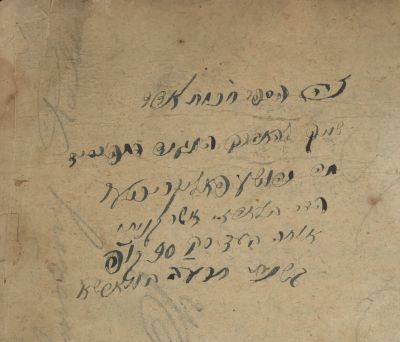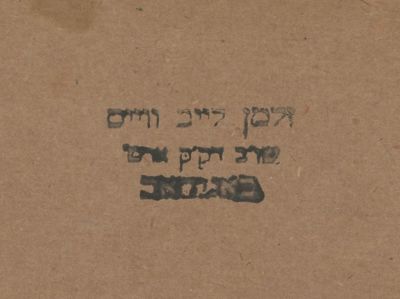1. Sefer Binas Yisoschor – Michalovtza, 1928. Stamp of Rabbi Shalom Moshe Halevi Ungar Rabbi in Neutra right after the Holocaust.
Later cloth covers, the last page repaired affecting text with a loss.
Otherwise a good sound copy.
2. Sefer Chochmas Adam, Yoreh Deah – Konigsberg, 1860.
by Rabbi Avraham ben Yechiel Michel Dantzig.
3. Sefer Yesod VeShoresh Ha’Avodah
by Rabbi Alexander Ziskind ben Moshe of Grodno. Prayers according to Kabbalistic. Warsaw, 1875
Signature: Meir Chaim Stern, Satmar. He also lived in Illok. Writing by his brother in law R’ Zev Wolf Ben R’ Yakov of Satmar in 1900.
Stamp: Aaron Katz Kohn.
Original covers, title tear and repaired not affecting text. wine-stained at Seder Pesach, page 67 lacking corner and text, many pages tattered, last four pages torn and missing text.
A used copy.
4. Shulchan Aruch, With commentary by Rabbi Yechezkel Halevi Landa. Halberstadt, 1861.
Copy of Rabbi Ahron Yisroel Rabbi of Ostrova.
5. Sefer Goren Nachon – Vilna, 1845.by Rabbi Shlomo ben Yehudah Gabirol. Jewish philosophy
Vilna, 1845. Incomplete copy.
6. Dedication by Zalmen Leib Weiss, Shochet in Boniyad to his son Rav Avraham David on the occasion of his marriage. Signature and stamp.
7. Shev Shmahatasa – Konigsberg, 1857.
Stamp of Rabbi Shaul Binyamin HaKohen Rabbi of Radashkovichy.
Rabbi Shaul Binyamin HaKohen Karelitz of Radashkovichy, founder of the "Etz Chaim Talmud Torah and Yeshiva" in Jerusalem was a disciple of Rabbi Yitzchak of Volozhin. He served as a young posek in Radashkovichy, and immigrated to Jerusalem ca. 1857, where he established a central Talmud Torah (boys’ school) in the city.
The creation of this Yeshivah was a fairly new idea as back in Radashkovichy Melamdim would teach children in a room at home, without centralized supervision. Rabbi Shimon Zarchi Rabbi of Tavrig (Tauragė) (1788-1860) was a co-founder of the Etz Chaim yeshiva. Rabbi Shaul Binyamin greatly supported the establishment of the Yeshivah the Etz Chaim yeshivah, and even acquired a courtyard as an asset to benefit the Talmud Torah. In 1863, a fierce dispute arose against him, when he registered the courtyard under his own name (as was customary in those days, due to the Ottoman law which did not allow land to be registered under the ownership of new public institutions), yet refused to give the rabbis of the city an offset document, confirming that the courtyard was not his private property.
The press in those days (HaMaggid and others) published many articles for and against R. Shaul Binyamin. Some even slandered him for scheming to introduce foreign studies in the Talmud Torah curriculum. The rabbis of Jerusalem publicized their views in the booklet Emet U’Mishpat (Jerusalem, 1863) and the rival party published a booklet surrounding the same affair named Dimat HaAshukim (Jerusalem, 1864), "regarding the booklet printed without Emet U’Mishpat (truth and justice)…". This dispute evolved to a demand for rabbinic supervision of the money raised for the Etz Chaim yeshiva and of the debts from the purchase of this courtyard.
Rabbi Shaul Binyamin later travelled to the United States in 1871 as an emissary of the Etz Chaim yeshiva together with R. Aryeh Leib HaKohen, at the behest of the Imrei Binah and Rabbi Shmuel Salant, and with time, he succeeded in repaying all the debts which he undertook for the purchase of this courtyard.
Konigsberg, 1857.
Original covers, front cover detached, title detached. Otherwise a good sound crisp copy.
8. Long dedication by R’ Avraham Abish Weidman of Humne to his son in law Aaron Meir Wolner.
Share this lot:


































































